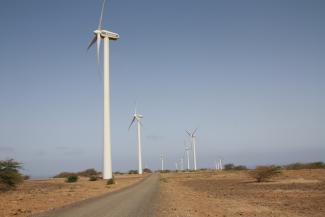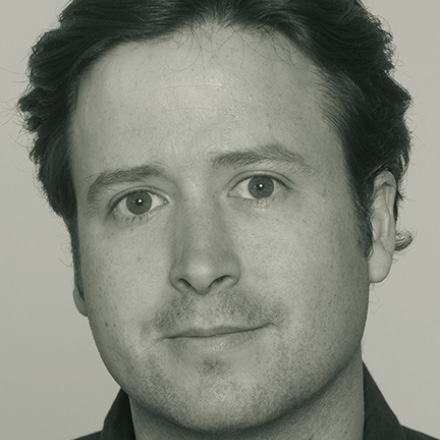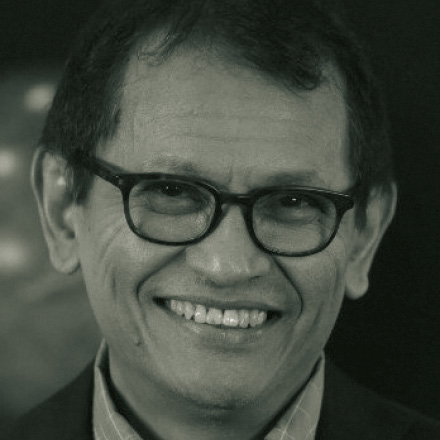Energy transition
The windy islands
 Toni Kaatz-Dubberke
Toni Kaatz-Dubberke
Adilson Barros runs a small barber shop in the centre of the Cape Verde’s capital, Praia. “It takes me 10 haircuts a month just to pay the electricity bill,” he complains. He only uses seven electrical appliances and, as a small consumer, he gets government-subsidised power. Nonetheless, he pays the equivalent of € 0.34 per kilowatt hour, significantly more than German consumers do.
Since its independence in 1975, Cape Verde has enjoyed fast development which is almost unprecedented in Africa. All 10 islands are electrified today. Power supply is based on diesel and gasoline generators. It is managed by Electra, a utility that runs power plants and operates the grid. It belongs to the national government to 80 %, and local governments hold the rest of the shares. Electra has the monopoly on power distribution, but power generation is a free market. Electra, however, is allowed to apply for all state tenders in this sector.
Since 2000, energy consumption in Cape Verde has doubled while the global market price for crude oil has more than tripled. So far, Cape Verde’s energy supply depends on expensive fuel imports. Small businesses, private households and large hotels must bear high costs, and so must the highly energy-intensive agriculture sector. As fresh water is scarce, sea water must be desalinated. All summed up, the IMF reckons that oil imports cost around € 136 million in 2013. To cope with rising fuel prices and to reduce the disproportionate dependence on crude oil, Cape Verde’s government spelled out an ambitious energy policy in 2002. “By 2020, we want 50 % of our energy to come from renewable sources, and we’ll see if we can reach as much as 100 %,” says Antonio Baptista,
a top-level officer at the Ministry of Industry, Energy and Tourism.
Favourable conditions
Due to its location in the middle of the Atlantic Ocean, Cape Verde has excellent conditions for wind and solar power generation: 350 days of sunshine and year-round wind speeds of an average of six metres per second. The islands need decentralised supply systems, because it isn’t possible to create a grid system for the entire country. The downside, however, is that surplus power on one island cannot be used on an another one.
There are several obstacles to achieving a fully renewable energy supply, such as power storage and network expansion. The grid capacity must improve. “So far, we have about 25 % penetration by renewable energy in Cape Verde, even without a storage system. We use diesel generators as a back-up, which can be adjusted according to how much wind and solar energy is produced,” says Delgado Jansenio of ECREEE. This acronym stands for “ECOWAS Centre for Renewable Energy and Energy Efficiency”. ECOWAS is the Economic Community of West African States. Delgado makes clear: “If we want to reach 50 %, we need new technologies that can compensate for fluctuations in power generation.”
With the support of ECREEE, Cape Verde has installed the largest solar park in West Africa. It accounts for about two percent of the total energy production in the country. ECREEE also advises other ECOWAS members. The centre was founded in Cape Verde’s capital Praia in 2010. ECREEE’s mandate is to promote renewable energy in the entire ECOWAS region. Its experts are working on strategies for all countries, and concepts for Senegal, Ghana and Nigeria have been finalised. ECREEE wants to tap the region’s enormous potential for renewable energy.
Cape Verde still faces big challenges. Solving technical problems costs money that the state doesn’t have. The government estimates the necessary investments will amount to around € 1 billion. It hopes to attract foreign private investors. “Our government will not invest,” says top-level officer Baptista. “We will open up our energy market to private companies by using international tenders.”
Since Cape Verde is not considered a developing country anymore, donors no longer grant it budget support or development loans. The island state must achieve its energy transition goals on its own. Tax incentives and duty-free treatment for imports of wind and solar systems are meant to attract foreign investors; and political stability is helpful in this context. A renewable energy act is currently being discussed. Until now, the new government has stuck to its 50 % target for 2020.
Full steam ahead
Peter Heck of the Birkenfeld-based Institute for Applied Material Flow Management (IfaS) recommends that Cape Verde aim for the ambitious 100 % target by 2020: “It would not make sense economically to go only for 50 %.” The reason is that Cape Verde would have to operate too many networks at the same time, and that would drive up costs. Assigned by the government of Cape Verde, IfaS this year presented a comprehensive strategy for powering every island entirely with renewables. “In principle, all technological problems are solved, and the technologies needed for power storage and network enhancement is available on the market,” says Heck.
In his eyes, the major obstacle to reaching the 100 % target is the lack of comprehensive legislation governing energy supply. Foreign investors want legal certainty, and the country urgently needs an oversight body to monitor who is producing and distributing energy by what means. IfaS has proposed to assign these tasks to a central holding company that would be responsible for all islands and also raise investment capital. The individual power plants on each island could be incorporated into such a holding company.
Heck insists, however, that “cherry picking must stop”. Currently, foreign companies are choosing only the best locations for power generation, without adhering to a broad, national concept. One such “cherry” is the largest wind farm on Cape Verde near Praia (see box on p. 424). Until the renewable energy act is passed, however, investors cannot be obliged to install windmills in less favourable locations.
Popular support
Cape Verde households that install solar panels of their own do not get any financial compensation for feeding excess energy into the grid. However, they can draw the same amount of power from the grid in return for free at another point in time. The import of solar panels is duty free. Due to such incentives and lower electricity bills, the local people support the transition to renewables. They understand that, if the policy succeeds, their country will not only be environmentally clean but also have cheap energy. Agriculture would become cheaper, for example, and manufacturing industries would become viable. Ana Monteiro of Cabéolica, an engineering company specialising in wind power, says she is often asked at conferences in Europe whether there is any popular resistance to the landscape being spoiled by towering windmill. The answer is no, says Monteiro. She adds: “In a country where electricity is expensive and, until recently, power outages could last for days on end, people are grateful for any development.” The Republic of Cabo Verde is a test case. If development continues as planned, the dependence on oil imports will be reduced, and people like the barber Adilson Barros will spend less on their electricity bills. If Cape Verde manages the energy transition, it will set a positive example for the whole of West Africa.
Toni Kaatz-Dubberke works for the GIZ in Togo in the area of administrative decentralisation and local development. toni.kaatz-dubberke@giz.de



